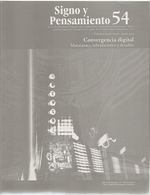Abstract
At the matrix technology room —a possibility offered by the Program of Journalism of Pontificia Universidad Javeriana— the native Amerindians of Sierra Nevada de Santa Marta, Colombia, went through a “conversion” and digital convergence experience to create and develop their own independent media. With Mother Nature’s due permission, they started a process of incorporating new technologies vis-à-vis the production of journalistic and audiovisual material in their languages supported by their traditional wisdom. Since then, they have continued their search for their own narrative identity in order to describe to their “younger brothers” what in fact happens in their territory, an environmental and spiritual reserve of humanity. In the following accounts, four of the workshop’s tutors describe what it was to participate in that intercultural gathering full of educational affects and challenges.
Didi-Huberman, G. (1997), Lo que vemos: lo que nos mira, Buenos Aires, Manantial.
Gil, S. (2008, marzo), “El video de los pueblos indígenas de la Sierra Nevada de Santa Marta” [conversatorio], Especialización en Televisión, Bogotá, Pontificia Universidad Javeriana.
Indigenous Media Project (2004), Through their Eyes: Learning to Document the World [en línea], Washington, National Geographic Society. Disponible en: http://ngm.nationalgeographic.com/ngm/0410 /feature3/ flash_pop_3.html. Recuperado: 15 de junio de 2008.
Rabiger, M. (2001), Tratado de dirección de documentales, Madrid, Omega.
Rey, G. (2008, 26 de febrero), “La comunicación en el laboratorio” [discurso], Lección Inaugural de la Facultad de Comunicación y Lenguaje, Pontificia Universidad Javeriana, Bogotá, Colombia.
This journal is registered under a Creative Commons Attribution 4.0 International Public License. Thus, this work may be reproduced, distributed, and publicly shared in digital format, as long as the names of the authors and Pontificia Universidad Javeriana are acknowledged. Others are allowed to quote, adapt, transform, auto-archive, republish, and create based on this material, for any purpose (even commercial ones), provided the authorship is duly acknowledged, a link to the original work is provided, and it is specified if changes have been made. Pontificia Universidad Javeriana does not hold the rights of published works and the authors are solely responsible for the contents of their works; they keep the moral, intellectual, privacy, and publicity rights.
Approving the intervention of the work (review, copy-editing, translation, layout) and the following outreach, are granted through an use license and not through an assignment of rights. This means the journal and Pontificia Universidad Javeriana cannot be held responsible for any ethical malpractice by the authors. As a consequence of the protection granted by the use license, the journal is not required to publish recantations or modify information already published, unless the errata stems from the editorial management process. Publishing contents in this journal does not generate royalties for contributors.


